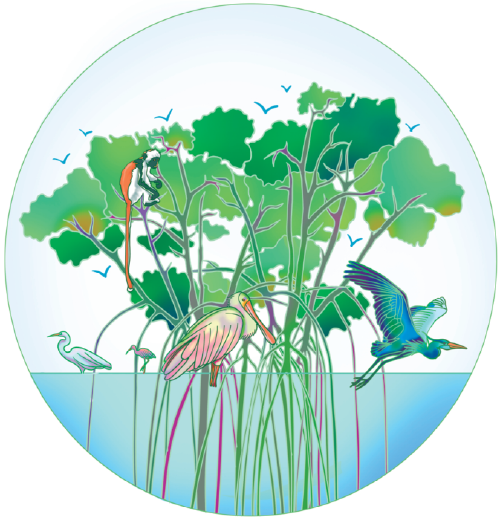Seize the moment

With less than seven years to go for achieving the UN Sustainable Development Goals, we are just in time for wetland restoration
From purifying water and providing clean water, to protecting people from storms and floods, maintaining critical ecosystems and biodiversity, and storing large amounts of carbon and mitigating climate change, wetlands are critical to human survival and prosperity.
However, globally, wetlands are under threat from both anthropogenic and natural causes. According to the Convention on Wetlands Secretariat, over 35 percent of the world's natural wetlands have been lost in the past 50 years, a rate that is three times that of forests. This means the key ecosystem services that wetlands provide to human beings are in grave peril. It is now critical to raise international awareness about wetlands and to encourage actions to protect and restore these important ecosystems and the services they provide.
Feb 2 marks the 27th World Wetlands Day, the theme being "Wetland Restoration". This emphasizes the urgent need to prioritize the restoration of lost or degraded wetlands and calls for everyone's participation.
The theme reflects efforts to heal the planet, promoted by the UN Decade of Ecosystem Restoration (2021-30) initiative, which is leading and inspiring the restoration of critical ecosystems including wetlands around the world. It provides an excellent opportunity to restore critical ecosystems such as wetlands. The theme is also in line with the ethos of the Wuhan Declaration adopted in November 2022 at the 14th Conference of the Contracting Parties to the Ramsar Convention on Wetlands (COP 14). The declaration reaffirms and emphasizes the importance of protecting, restoring and rationally using wetland resources to address climate change, enhance biodiversity conservation and promote sustainable development, and calls for "urgent measures to achieve the goal of halting and reversing the loss of wetlands globally".
Wetland restoration can bring a range of benefits, such as enhanced biodiversity and ecosystem stability, increased carbon storage and reduced emissions for climate change mitigation and adaptation, better protection of people and their property against natural disasters such as floods and storms, and improved tourism development which can secure more sustainable livelihoods for more local people and contribute to poverty alleviation.
Thus, wetlands restoration can directly contribute to achieving the relevant goals of the Convention on Wetlands, the Convention on Biological Diversity and the United Nations Framework Convention on Climate Change. While continuing and strengthening traditional in-situ approaches for nature conservation, the Post-2020 Global Biodiversity Framework adopted at CBD COP 15 in December 2022 highlights the important role of ecosystem restoration in reversing biodiversity loss, as reflected in its Target 2: "Ensure that by 2030 at least 30 percent of areas of degraded terrestrial, inland water, and coastal and marine ecosystems are under effective restoration, in order to enhance biodiversity and ecosystem functions and services, ecological integrity and connectivity". The nature-based climate change adaptation and mitigation actions of the UNFCCC are directly related to the restoration and protection of critical ecosystems, including wetlands. Both biodiversity conservation and the response to climate change are closely related to wetland protection and restoration, and are integral parts of the efforts to achieve the UN Sustainable Development Goals.
Over the past decade, the Chinese government has introduced and implemented a series of overall plans related to wetland protection and restoration, such as the Programme for a Wetland Protection and Restoration System, the National Master Plan of Major Projects for Protection and Restoration of Key Ecosystems (2021-35), and the National Wetland Protection Plan (2022-30), which all have specific contents on and requirements for wetland restoration. The National Wetland Protection Plan, which was released in December 2022, particularly proposes to adopt near-natural measures for the comprehensive improvement and systematic restoration of wetlands in those areas where the ecological functions of wetlands are seriously degraded, such as the lower-reaches of the Yellow River and coastal areas of the Yellow Sea and Bohai Sea. In addition, some tailor-made special action plans on wetland restoration have been developed and put in place, such as the Special Action Plan for Mangrove Protection and Restoration (2020-25) and the Special Action Plan for Spartina alterniflora Control (2022-25). The former special action plan requires not only the afforestation of 9,050 hectares of new mangrove forests, but also the restoration of 9,750 hectares of degraded mangroves by the end of 2025, while the latter requires a 90 percent removal rate of Spartina alterniflora nationwide by 2025 to effectively curb the spread of this invasive species.
China has come a long way in wetland restoration. Over the past 20 years, the country has increased its mangrove area — from 22,000 hectares to 27,100 hectares today, making it one of the few countries in the world to have increased its mangrove area. In the 13th Five-year Plan (2016-20), China restored 1,500 kilometers of its coastline and 30,000 hectares of coastal wetlands.
The Paulson Institute has not only witnessed but also participated in the restoration of wetlands in China over the past decade, especially in the areas of Spartina alterniflora control and studies on mangrove protection and restoration strategies. Since 2014, the institute has drawn the attention of the relevant Chinese government agencies to the threats and control of Spartina alterniflora and put forward practical control suggestions.
Each individual can take a variety of actions to contribute to wetlands restoration and protection, for example, making conscious choices to minimize our own impacts on wetlands, speaking out persuasively to educate and activate others to get involved in wetland restoration, and acting boldly to engage in local wetland restoration.
We are now less than seven years away from the deadline to achieve the UN Sustainable Development Goals and the targets set by the CBD's Post-2020 Global Biodiversity Framework. Reversing the trend of rapid degradation or loss of wetlands is critical to achieving these goals.
The author is an adviser at the Paulson Institute, and an associate professor at Beijing Normal University. The author contributed this article to China Watch, a think tank powered by China Daily.
By SHI JIANBIN | China Daily
专业会员
| 我也说两句 |
| 版权声明: 1.依据《服务条款》,本网页发布的原创作品,版权归发布者(即注册用户)所有;本网页发布的转载作品,由发布者按照互联网精神进行分享,遵守相关法律法规,无商业获利行为,无版权纠纷。 2.本网页是第三方信息存储空间,阿酷公司是网络服务提供者,服务对象为注册用户。该项服务免费,阿酷公司不向注册用户收取任何费用。 名称:阿酷(北京)科技发展有限公司 联系人:李女士,QQ468780427 网络地址:www.arkoo.com 3.本网页参与各方的所有行为,完全遵守《信息网络传播权保护条例》。如有侵权行为,请权利人通知阿酷公司,阿酷公司将根据本条例第二十二条规定删除侵权作品。 |
 m.quanpro.cn
m.quanpro.cn


